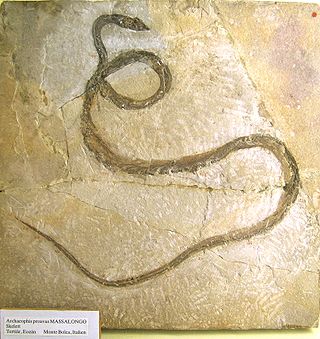
Monte Bolca is a lagerstätte near Verona, Italy that was one of the first fossil sites with high quality preservation known to Europeans, and is still an important source of fossils from the Eocene.

Weevers are nine extant species of fishes of family Trachinidae, order Trachiniformes, part of the Percomorpha clade. They are long, mainly brown in color, and have venomous spines on their first dorsal fin and gills. During the day, weevers bury themselves in sand, just showing their eyes, and snatch prey as it comes past, which consists of shrimp and small fish.
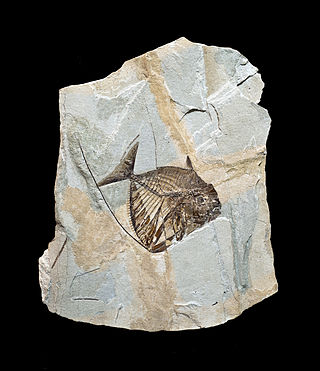
Mene rhombea is an extinct perciform fish belonging to the family Menidae. During the Middle Eocene, about 48 to 40 mya, these fishes lived in the Tethys Ocean, a large tropical sea in the area corresponding to the current Mediterranean. This ocean was extended between the continents of Gondwana and Laurasia. At this time, where Monte Bolca is today, M. rhombea, and its relative, M. oblonga, lived in a tropical lagoon.

Bolca is a village in the Veneto, on the southern margin of the Italian Alps. It is a frazione of the comune of Vestenanova, in the province of Verona. The area is famous for the marine fossils from the lagerstätte of Monte Bolca. It was one of the first fossil sites with high quality preservation known to Europeans, and is still an important source of fossils from the Eocene.
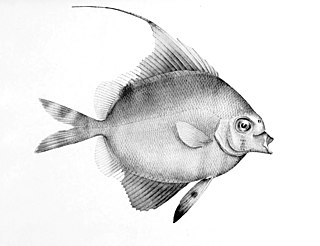
Sailfin moonfishes are a small family, Veliferidae, of lampriform fishes found in the Indian and western Pacific Oceans. Unlike other lampriforms, they live in shallow, coastal waters, of less than 100 m (330 ft) depth, rather than in the deep ocean. They are also much smaller than most of their relatives, up to 30 cm (12 in) in length, and have deep, rather than elongated, bodies. They are characterised by their ability to retract the anterior rays of their dorsal and anal fins into a sheath.
Dussumieriidae is a family of clupeiform fishes popularly called the "round herrings". It is now recognized by FishBase as a family in its own right; it had been considered to be a subfamily of Clupeidae. It contains two extant genera, and one extinct genus from the Ypresian of Monte Bolca.
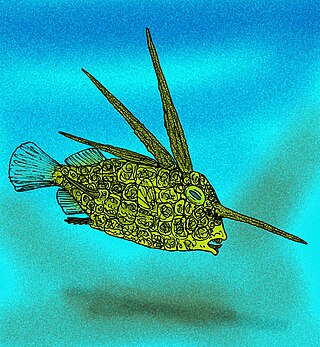
Eospinus daniltshenkoi is an extinct tetraodontid bony fish from the Eocene. Its fossils are from the Danata Formation lagerstatten of Ypresian Turkmenistan.

Bajaichthys elegans is an extinct Lutetian zeid from the Monte Bolca Lagerstätten.

Mene oblonga is a species of ray-finned fish that first appeared in the Monte Bolca Lagerstatten during the Lutetian epoch of the Eocene. For a menid, it has a very shallow body, especially in comparison with the sympatric Mene rhombea. Its fossils are very rare in Monte Bolca. A single fossil from the early Oligocene, referred to as "Mene oblonga var. pusilla," was found in Chiavon, Italy.
Palaeopomacentrus orphae is an extinct species of fish from the Ypresian epoch of Monte Bolca. It is the only known species of the genus Palaeopomacentrus.

Spinacanthus cuneiformis is an extinct prehistoric tetraodontid bony fish that lived from the Lutetian epoch of Eocene Monte Bolca.

Bolcyrus is an extinct genus of prehistoric bony fish that lived from the early to middle Eocene.

Eoplatax is an extinct genus of prehistoric spadefish that lived during the Lutetian of Monte Bolca. They are closely allied to the extant genus, Platax, more commonly known as "batfish."
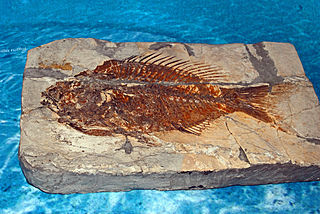
Sparnodus is an extinct genus of prehistoric perciform fish in the family Sparidae. Species of this genus were nektonic carnivore. These fishes lived in the Cenozoic Era, in Oligocene and Paleocene.

Protobalistum imperiale is an extinct prehistoric tetraodontid bony fish that lived from the Lutetian epoch of Eocene Monte Bolca.
Pietschellus is an extinct genus of enigmatic bony fish which existed in northern Italy during the early Eocene epoch. It is known from a single well-preserved nearly complete specimen recovered from the Monte Postale site of the Monte Bolca locality. It was first named by Alexandre F. Bannikov and Giorgio Carnevale in 2011 and the type species is Pietschellus aenigmaticus.

Spinacanthidae is an extinct prehistoric family of tetraodontid bony fish that lived from the Lutetian epoch of Eocene Monte Bolca.

Pristigenys is a genus of marine ray-finned fish in the family Priacanthidae. It contains five extant species and one extinct species, P. substriata, which is known from fossils found in the Eocene of Monte Bolca, Italy.
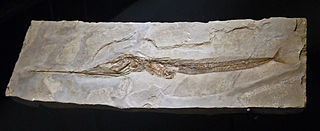
Blochius longirostris is a species of prehistoric fish belonging to the family Blochiidae. This fish lived in the middle Eocene and its fossils have been found exclusively in the well-known Monte Bolca (Italy).

Siphonostomites hesionoides is a species of polychaete annelid known only from subtidal lagoon deposits from the Early Eocene of Monte Bolca, Verona, Italy.















